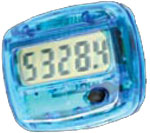 Regular endurance exercise has helped Tom stay healthy after major heart surgery:
Regular endurance exercise has helped Tom stay healthy after major heart surgery:
“At age 45 I had quadruple bypass surgery. I was shocked because I was so young. Those months after my surgery are a blur to me now. After several months of cardiac rehab, I knew my heart health was in my hands. So, now I run regularly at my neighborhood YMCA — around the track in nice weather and on the treadmill during the winter. I admit I was nervous at first to push myself. I worried I might do more harm than good. But, it’s been 12 years and I feel great! This year, I will celebrate my daughter’s graduation from college, continue to root for the Aggies, and maybe even teach my wife to play golf. I believe exercise has made all of that possible for me.”
How to Improve Your Endurance
Endurance exercises are activities — walking, jogging, swimming, raking, sweeping, dancing, playing tennis — that increase your heart rate and breathing for an extended period of time. They will make it easier for you to walk farther, faster, or uphill. They also should make everyday activities such as gardening, shopping, or playing a sport easier.
 How Much, How Often
How Much, How Often
Refer to your starting goals, and build up your endurance gradually. If you haven’t been active for a long time, it’s especially important to work your way up over time. It may take a while to go from a longstanding inactive lifestyle to doing some of the activities in this section. For example, start out with 5 or 10 minutes at a time, and then build up to at least 30 minutes of moderate-intensity endurance activity. Doing less than 10 minutes at a time won’t give you the desired heart and lung benefits.
Try to build up to at least 30 minutes of moderate-intensity endurance activity on most or all days of the week. Every day is best. Remember, though, that these are goals, not rules. Some people will be able to do more.
Others, however, may not be able to exercise for 30 minutes at a time. It’s important to set realistic goals based on your own health and abilities.
|

Some people are afraid to exercise after a heart attack. But regular physical activity can help reduce your chances of having another heart attack.
If you’ve had a heart attack, talk with your doctor to be sure you’re following a safe, effective physical activity program. Ask about cardiac rehab programs, which include exercise, education, and counseling to help you return to an active life. |
Counting Your Steps
Step counters can help you keep track of your endurance activity, set goals, and measure progress. Most inactive people get fewer than 5,000 steps a day, and some very inactive people get only 2,000 steps a day.
Wear the step counter for a few days to see how you’re doing. You can use the Endurance Daily Record in Chapter 7 to record your steps. If you get:
- Fewer than 5,000 steps a day, gradually try to add 3,000 to 4,000 more steps a day.
- About 8,000 steps a day, you’re probably meeting the recommended activity target.
- 10,000 or more steps a day, you can be confident that you’re getting an adequate amount of endurance activity.
- 10,000 steps a day comfortably, try for 15,000 steps a day, which would put you in the high-activity group.
|

Walking 2 miles a day at the mall will help you keep up with your grandchildren during a trip to the park.
|
Safety
Listen to your body. Is the activity making you feel unwell or too tired? Endurance activities should not make you breathe so hard that you can’t talk. They should not cause dizziness, chest pain or pressure, or a feeling like heartburn.
Do a little light activity, such as easy walking, before and after your endurance activities to warm up and cool down.
As you get older, you may not feel thirsty even though your body needs fluids. Be sure to drink liquids when doing any activity that makes you sweat. By the time you notice you are thirsty, you probably are already low on fluid. This guideline is important year round, but it’s especially important in hot weather. If your doctor has told you to limit your fluids, be sure to check before increasing the amount of fluid you drink while exercising. For example, people with congestive heart failure or kidney disease may need to limit fluids.
Older adults can be affected by heat and cold more than others. In extreme cases, too much heat can cause heat stroke, and very cold temperatures can lead to a dangerous drop in body temperature. If you are going to be outdoors, dress in layers so you can add or remove clothes as needed. When it’s not possible to be outdoors, you may want to try indoor activities:
- If you have stairs at home, go up and down the steps a few times in a row.
- Walk at the mall or grocery store.
- Go for a swim at your local fitness or recreation center.
Whatever activity you choose, stay safe. To prevent injuries, be sure to use safety equipment. For example, wear a helmet when bicycling. When you’re walking, watch out for low-hanging branches and uneven sidewalks. Walk during the day or in well-lit areas at night, and be aware of your surroundings. Ask someone to go with you. Wear the proper shoes (see "Getting the Right Shoes" in Chapter 2).
|
 |
go here for more info
For more about drinking enough fluids, see Chapter 6. |
|
Progressing
When you’re ready to do more, build up the amount of time you spend doing endurance activities first, then build up the difficulty of your activities. For example, gradually increase your time to 30 minutes over several days to weeks (or even months, depending on your condition) by walking longer distances. Then walk more briskly or up steeper hills. See Chapter 1 for more examples of physical activities that build endurance. To record your activities, use the Endurance Daily Record in Chapter 7.
|
 Ways to Gauge Your Effort Ways to Gauge Your Effort
The amount of effort you need to do an activity will depend on your starting point, including your fitness level, how strong you are, and how active you’ve been. For example, walking a mile in 15 minutes will be a lot easier for someone who does it every day compared with someone who has never done it. You can use these informal guidelines to estimate how much effort you are putting into your endurance activities:
- Brisk walking is an example of moderate activity, while jogging is a vigorous activity.
- Talking is easy during moderate activity. During vigorous activity, talking is difficult.
- If you tend to sweat, you probably won’t sweat during light activity (except on hot days). You will sweat during vigorous or sustained moderate activity. Remember to drink fluids even if you don’t sweat.
One doctor who specializes in exercise for older adults tells her patients the following about how hard they should work during endurance activities: “If you can’t talk while you’re exercising, it’s too difficult. If you can sing a song, it’s too easy!” |
<<Back | Next >>
